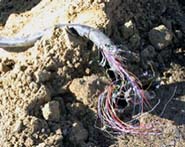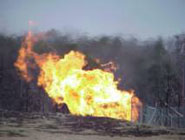


call for details
This high-pressure gas meter is the only indication that there are buried natural-gas lines in the area underneath this playground. Visual cues that indicate the presence of underground utilities are often hard to see.

Above is a map showing inter- and intra-state natural gas pipelines. These are large-scale pipelines are the backbone of our national liquified natural gas distribution network.

Before digging caution should be exercised. Any kind of buried utility could be right under the area where you are about to excavate.

The amount of services supporting our economy necessitates the constant addition and upgrade of underground utilities. Excavation operations must always have safety in mind. Most operations involve high-capacity excavation equipment that can move massive amounts of earth, but if used carelessly can quickly destroy underground pipes.
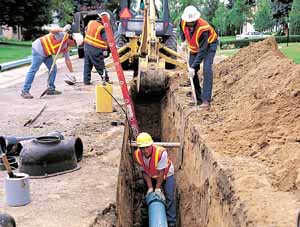
Roadways offer a ready-made path to allow the installation of underground pipe for gas, electricity, and sewer lines.
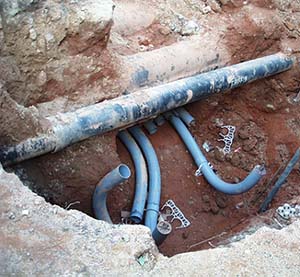
A large number of conduits are being run under existing utilities. As population densities increase the number of buried utilities is only going to increase. Meeting deadlines during construction often means that field changes in the location of utilities are not logged increasing the chances that future excavations will cause damage to utilities that have not been properly marked.

Building upgrades often require additional electrical conduits. Above are nine 4" conduits being installed in this small space.

Modern utilites are often brought into massive concrete vaults, like the one pictured above. It is within these vaults that services can interconnect and provide an easy pathway for later upgrades or addtions to underground services.
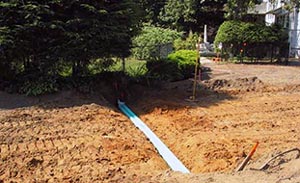
Residential installations of high-capacity conduit can be located anywhere when an entire area has been cleared for excavation.

Later the trench is back filled and compacted. Additional layers of soil may be added to landscape the area.

When the finished surface of the driveway is completed the location of the underground utilities will be lost unless meticulous records and construction photographs are available.
|
City streets are meant to be trenched. Above a long excavation trench has already been backfilled and readied to recieve a final layer of pavement.
The intersection above shows a criss-cross pattern of prior excavations. If the entire area had been resurfaced the location of prior installations of underground utilites would be unknown unless very accurate records had been kept.
Telecommunication cables are extremely easy to damage. The cable above consists of 1800 pairs of wires. Each pair of wires provides standard phone service to a residence. While excavating a contractor destroyed ten of these cables. A total of 18,200 pairs, or 36,400 individual wires were severed. To repair this damage both sides of the splice must be checked. In today's world of high-speed internet, and business-critical phone systems having your phone lines go dark can create an huge legal liabilty for the contractor that caused the damage.
Another severed telecom line happened to provide all data, fax, phone, and catalog functionality to a local library. This cut was the result of a simple pavement upgrade in front of the library.
Warning markers clearly delineate areas where excavation would be dangerous.
Trenching equiipment is designed to quickly move massive amouts of soil so that all manner of underground utilities may be installed.
When trenching operations are underway different levels are reached as the trench gets deeper. First topsoil, then hard fill such as the large agregate removed in the photo above.
When warning signs are ignored a gas-pipeline explosion can occur.
Even if an explosion is avoided, the entire area must be immediately evacuated. The repair to the ruptured line can take days. All costs for fire, rescue, and repair are billed to the contractor that was in charge of the excavation.
|
RADAR | XRAY | POST TENSIONED CONCRETE | SPECIALTY PROJECTS | CONSULTING | UTILITY LOCATING | ABOUT | HOME




